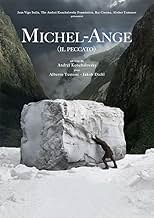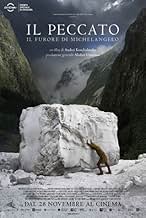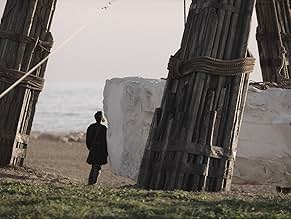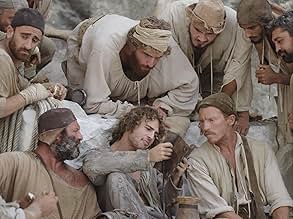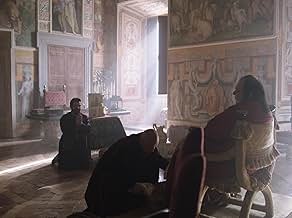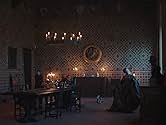Il peccato
- 2019
- 2 घं 14 मि
IMDb रेटिंग
6.8/10
1.5 हज़ार
आपकी रेटिंग
अपनी भाषा में प्लॉट जोड़ेंThe life of Michelangelo Buonarroti.The life of Michelangelo Buonarroti.The life of Michelangelo Buonarroti.
- निर्देशक
- लेखक
- स्टार
- पुरस्कार
- 3 जीत और कुल 2 नामांकन
फ़ीचर्ड समीक्षाएं
Nice work with beautiful scenes recreating the atmosphere of those times perfectly well.
Michaelangelo was a genius sculptor and each of his creations move the soul even of modern people, lots of whom have hardly any taste of art at all. This film is artistic enough, beautiful and talented, made by a very professional director of soviet school. Just the right background to tell a story of a genius.
No soundtrack can also mean no noise pollution. I enjoyed everything about this movie
This movie has left me without blinking during the more than two hours it lasts. With beautiful photography, a hard and dry plot, and hypnotic images for its approach to an Italian Renaissance as it must have been in reality, dirty, poor and tremendously unfair.
The actors seem sculpted against the beautiful background of Tuscany with the same rawness that we find in Pasolini's films. We must not forget that Konchalovskiy collaborated with Tarkovsky in the birth of the story of another tormented artist, 'Andrei Rublev', one of his masterpieces.
From the beginning of the film we see Michelangelo in his maturity, when the intense and fierce compulsion of his sculptural works, which seem to relax only in his 'Pieta', are those of a man pursued by 'the devil' -as his character says-, obsessed by money, in a purely masculine world, far from femininity, compassion and subtlety.
The central scene of 'Il Peccato' has been compared to a certain scene in the movie 'Fitzcarraldo' and they are not wrong, because there is dementia linked to the search for a goal that constantly escapes, no matter how much effort is made, and all this is told in a way that takes your breath away. Although it is not a drama, it is the life of someone at the limit of his strength.
Highly recommended.
The actors seem sculpted against the beautiful background of Tuscany with the same rawness that we find in Pasolini's films. We must not forget that Konchalovskiy collaborated with Tarkovsky in the birth of the story of another tormented artist, 'Andrei Rublev', one of his masterpieces.
From the beginning of the film we see Michelangelo in his maturity, when the intense and fierce compulsion of his sculptural works, which seem to relax only in his 'Pieta', are those of a man pursued by 'the devil' -as his character says-, obsessed by money, in a purely masculine world, far from femininity, compassion and subtlety.
The central scene of 'Il Peccato' has been compared to a certain scene in the movie 'Fitzcarraldo' and they are not wrong, because there is dementia linked to the search for a goal that constantly escapes, no matter how much effort is made, and all this is told in a way that takes your breath away. Although it is not a drama, it is the life of someone at the limit of his strength.
Highly recommended.
Knowledge. Loyalty. Truthfulness. Guilt. Perseverance. Effort. Strength. Love. Spirituality.
If you want to learn a thing or two about the above, it's a must to watch.
I found watching Il Peccato / Sin (2019) a delight!
Some user reviews of this film express their disappointment in the fact that you don't see the great master in action, working on marble or drawing. But I see that differently. Being trained as an art historian, I recognized the events and characteristics of Michelangelo shown in this film from the historical documents that have survived from that time. Having spent a significant amount of time studying the subject before making the film, I believe Konchalovskiy in particular closely read Giorgio Vasari's Lives of the Most Excellent Painters, Sculptors, and Architects (1550/1568), a contemporary collection of biographies of Renaissance artists (in the case of Michelangelo, Vasari knew him personally), as the major themes in the film correspond with Vasari's account of this episode in Michelangelo's long life.
Echoing his early masterpiece Andrey Roublev (1966), which he made together with Andrei Tarkovsky, Il Peccato shows how artists are subjects of the time they live in, dependent on power structures and turbulences in violence and prosperity. The film gives a good insight in Michelangelo's social interactions with his family, rivalling artists, and patrons. Moreover, the cinematography is impressive, and the largely unprofessional acting crew performed overall very strong. A great addition to the genre of movies about artists, much more nuanced and intelligent than the classic The Agony and the Ectasy (1965). Hopefully, Michelangelo's rival Leonardo da Vinci will get a biopic of comparable quality soon!
Some user reviews of this film express their disappointment in the fact that you don't see the great master in action, working on marble or drawing. But I see that differently. Being trained as an art historian, I recognized the events and characteristics of Michelangelo shown in this film from the historical documents that have survived from that time. Having spent a significant amount of time studying the subject before making the film, I believe Konchalovskiy in particular closely read Giorgio Vasari's Lives of the Most Excellent Painters, Sculptors, and Architects (1550/1568), a contemporary collection of biographies of Renaissance artists (in the case of Michelangelo, Vasari knew him personally), as the major themes in the film correspond with Vasari's account of this episode in Michelangelo's long life.
Echoing his early masterpiece Andrey Roublev (1966), which he made together with Andrei Tarkovsky, Il Peccato shows how artists are subjects of the time they live in, dependent on power structures and turbulences in violence and prosperity. The film gives a good insight in Michelangelo's social interactions with his family, rivalling artists, and patrons. Moreover, the cinematography is impressive, and the largely unprofessional acting crew performed overall very strong. A great addition to the genre of movies about artists, much more nuanced and intelligent than the classic The Agony and the Ectasy (1965). Hopefully, Michelangelo's rival Leonardo da Vinci will get a biopic of comparable quality soon!
As a biopic about Michelangelo, it will most likely leave you with more questions about the man that you initially had. The narrative is very cryptic and revolves around him trying to balance his art around commissions and orders he has no hope of actually fulfilling.
Most of the movie is spent on "the monster," a marble block he considers more important than any of his responsibilities or desires. But when it comes down to actually watching the transportation, it is just an accident waiting to happen. You know that it's coming, and yet it is surprising nonetheless when it does.
The plot is stitched with bits and pieces of his life and relationships with multiple Popes he lived through. It only makes sense if you already know anything there is to know about his biography. The movie will not bother establishing differences between the pope factions or highlighting the significance of the events. You are on your own in this one.
His character also becomes more confusing as it goes along, his clear perfectionism and suspicion of everyone stem from vaguely alluded conspiracies around him that start and end abruptly, sometimes in the same scenes. His obsession with the monster and willingness to betray everyone and everything for it is captivating, however, his revelation at the end just seems way too nebulous for it to be understood by anyone except him, and maybe this is how it should be. The best aspect of Michelangelo that the movie so carefully and authentically portrays is that, despite looking like a local madman who has to beg on a street, he was never poor; his tight-fistedness is something of a legend in and of itself. Including a chest full of ducats under his bed that he just doesn't spend while living in what amounts to poverty.
Speaking of which, the mise-en-scene of the medieval cities is impeccable. It's one of those ultra-authentic dirty movies that doesn't resort to erasing color everywhere to show the dirt. No, everything can be vibrant while the roads are made of layers upon layers of mud. That's not a contradiction. Everyone is sweaty with their unwashed clothes full of holes and tears. All this only highlights the absolute beauty of his creations.
Most of the movie is spent on "the monster," a marble block he considers more important than any of his responsibilities or desires. But when it comes down to actually watching the transportation, it is just an accident waiting to happen. You know that it's coming, and yet it is surprising nonetheless when it does.
The plot is stitched with bits and pieces of his life and relationships with multiple Popes he lived through. It only makes sense if you already know anything there is to know about his biography. The movie will not bother establishing differences between the pope factions or highlighting the significance of the events. You are on your own in this one.
His character also becomes more confusing as it goes along, his clear perfectionism and suspicion of everyone stem from vaguely alluded conspiracies around him that start and end abruptly, sometimes in the same scenes. His obsession with the monster and willingness to betray everyone and everything for it is captivating, however, his revelation at the end just seems way too nebulous for it to be understood by anyone except him, and maybe this is how it should be. The best aspect of Michelangelo that the movie so carefully and authentically portrays is that, despite looking like a local madman who has to beg on a street, he was never poor; his tight-fistedness is something of a legend in and of itself. Including a chest full of ducats under his bed that he just doesn't spend while living in what amounts to poverty.
Speaking of which, the mise-en-scene of the medieval cities is impeccable. It's one of those ultra-authentic dirty movies that doesn't resort to erasing color everywhere to show the dirt. No, everything can be vibrant while the roads are made of layers upon layers of mud. That's not a contradiction. Everyone is sweaty with their unwashed clothes full of holes and tears. All this only highlights the absolute beauty of his creations.
क्या आपको पता है
- ट्रिवियाShot entirely in Italy. The movie was shot in Rome and its environs and in Tuscany, including at the Carrara quarry where Michelangelo got his marble.
- भाव
Michelangelo Buonarroti: Money always rubs elbows with infamy.
- कनेक्शनReferenced in Vecherniy Urgant: Andrei Konchalovsky/Pompeya (2019)
टॉप पसंद
रेटिंग देने के लिए साइन-इन करें और वैयक्तिकृत सुझावों के लिए वॉचलिस्ट करें
- How long is Sin?Alexa द्वारा संचालित
विवरण
बॉक्स ऑफ़िस
- बजट
- €1,50,00,000(अनुमानित)
- दुनिया भर में सकल
- $2,43,043
- चलने की अवधि2 घंटे 14 मिनट
- रंग
- पक्ष अनुपात
- 1.33 : 1
इस पेज में योगदान दें
किसी बदलाव का सुझाव दें या अनुपलब्ध कॉन्टेंट जोड़ें


![Trailer [OV] देखें](https://m.media-amazon.com/images/M/MV5BYThkZDVkMGQtNGZiYS00NzMwLWFkOWUtYTFhYThiN2E4MTQwXkEyXkFqcGdeQXRyYW5zY29kZS13b3JrZmxvdw@@._V1_QL75_UX500_CR0)
